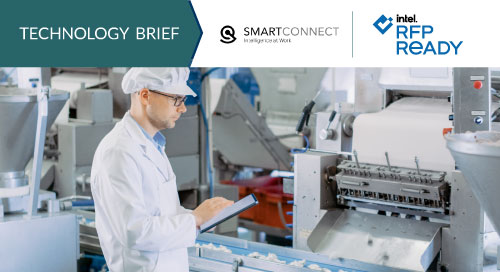Fill form to unlock content
Error - something went wrong!
Your content is just a step away. Please submit below.
Thank you!
Real-Time Data Analytics Drive More-Efficient Operations

Managing assets is not easy. When you oversee a fleet of vehicles, for example, you need contextually accurate and detailed information. Simply measuring the maximum and minimum temperatures of the coolant in a vehicle whenever it is refueled is hardly enough to know what is going to break down and when. And an engine light warning is too generic—it could mean something serious like the radiator is about to give way or signal something harmless.
The Case for Real-Time Data Analytics
Asset-intensive industries are saddled with a range of data-related problems. Too often, asset managers act on information that is irrelevant or outdated. Even within an organization, the data the frontline worker needs to see and act on need not be the same as what’s necessary for plant managers to do their job. And the mechanisms to signal a problem, such as text alerts, might be in place, but false positives make workers complacent. Too much of the wrong and irrelevant information can lead to data fatigue. Finally, even when data is at hand, you might not have enough of it to make an informed decision.
These data problems are pervasive across industries, says Sahid Sesay, President of SmartConnect IoT, a provider of sensor data management solutions. It’s why asset managers and other frontline personnel need to have more relevant data in real time so they can make accurate data-driven decisions and be proactive rather than reactive.
The company’s no-code SC-IoTOS Sensor Edge Gateway Software—an IoT sensor data capture translation aggregator—connects any Intel® processor-based hardware to virtually any type of equipment, sensor, or camera at the edge. It securely collects, stores, normalizes, and streams captured data to and from anywhere and makes it available for analysis and further processing. Such a solution delivers the right kind of data at the right time and to the right person.
“When you increase the amount of quality streaming data, it puts decision-making and information at people’s fingertips across the organization,” Sesay says. And in the age of digital and industrial transformation, such access to meaningful and actionable insights is exactly what organizations need.
Ease of Operational Data Management Helps Systems Integrators
Integration of data sources within existing technology stacks and infrastructure is another significant hurdle that companies often must cross before they can access insights. The SmartConnect solution makes use of legacy intelligence and asset management systems adding sensors as needed for desired metrics. By integrating data from both legacy and new sensors into one no-code information layer, the IoT solution eliminates the barrier to insights—a struggle for many companies.
There’s no custom work involved in layering the SmartConnect IoT solution onto existing data harvesting mechanisms, which lowers its price and makes the product popular with systems integrators. “Systems integrators can respond quicker to requests for proposals and remove risk from their operations. When they want to grow, they can grow without additional overhead. The solutions scale inherently. Going from PoC or pilot to production in a single step is normal. Plus, they can expand or adapt geographically and logically as needed,” Sesay says.
Data Integration Use Case
Using the SmartConnect solution helps a North Carolina-based food processing company find problems in its workflows and manage its operations better.
Sensors were monitoring a variety of parameters for asset management of refrigeration units and conveyor belts—from vibration to temperature and pressure and the health of motors. With multi-vendor sensors that monitor and control equipment and production processes, there was no unified streaming data that reflects the actual health of the assets.
To solve this data gap problem, the company deployed an Intel-powered edge compute server on the factory floor, running SmartConnect SC-IoTOS software—integrating and processing on-prem data in the cloud to deliver real-time data analytics. The deployment enables a sustainable approach for all relevant stakeholders to access the information they need to keep operations running.
Before the processing plant started using the SC-IoTOS server to ensure a steady stream of data, asset health data flowed in only every few weeks, leaving wide gaps in the performance evaluation of critical and disparate assets. Even mistakes that seemed minor, like leaving the refrigerator door open, would lead to health code violations and expensive repercussions. But now real-time data analytics in context, with alerts sent out to the right people, improves productivity and performance—helping the company manage assets proactively, reduced downtimes, and realizing more value for the assets.
Asset-heavy industries like cement, steel, mining, pulp and paper #manufacturing, and pharmaceuticals can all benefit from integrated live-streamed #data to prolong the health of machines. @SmartconnectIot via @insightdottech
A Future with Streaming Data for Asset Management
The basic thesis behind SmartConnect, making more relevant data analytics available in real time and sending text-based alerts if needed, is not confined to just a couple of use cases. As time is of the essence, response and maintenance services can be redesigned to higher efficiency levels.
The sky’s the limit for implementations. Asset-heavy industries like cement, steel, mining, pulp and paper manufacturing, and pharmaceuticals can all benefit from integrated live-streamed data to prolong the health of machines.
Areas of operation may include filling lines, packing of goods, and assessing machine states and possibility of failure.
Equally important, moving away from difficult-to-master programmable logic controllers to easier no-code software plus microprocessor-based gateways makes automation more widely accessible to manufacturers everywhere. “We’re bringing automation capabilities for the end user around the world,” Sesay says.
Equitable access to automation through no-code and lower-cost software will upend how and where the world manufactures its goods. And data-driven operations will mean the most efficient processes possible. With the democratization of data insights, companies big and small will no longer have to fly blind.
Edited by Georganne Benesch, Editorial Director for insight.tech.